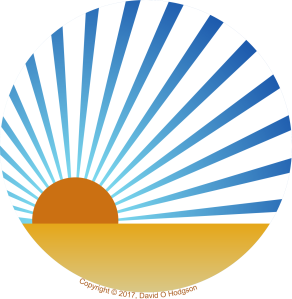
Old World Dove Meets New World Dove
The image above is actually a combination of two separate photographs taken within a few seconds, because the birds involved wouldn’t oblige by moving closer to each other! What’s remarkable about the image is that it shows, in the same location, an Old World dove alongside its nearest New World equivalent. It’s an extremely unusual example of two such species being in the same place at the same time.
One of the inconveniencies of emigrating to a new continent, as I did about 30 years ago, was that I discovered that my knowledge of natural history had suddenly become inadequate, and at least partially irrelevant.
Start Learning All Over Again!
Growing up, I’d learned to recognize and name most British bird species, but now I found myself faced with an complete new set of bird species, almost none of which were the same as those that had become familiar to me in the “old country”.
I noticed quite quickly that there were many cases where a particular ecological niche that was occupied by one species in Britain was occupied by a different species in California (a type of Convergent Evolution). Sometimes, the two species are closely related and even look very similar, but there are other cases where the relationship is more distant and the species obviously differ in appearance.
In the photo above, on the left is an Old World Eurasian Collared Dove (Streptopelia decaocto), while on the right is an American Mourning Dove (Zenaida macroura). Although they are different species, their behavior and lifestyle are highly reminiscent of each other. Their calls even sound very similar.
In many cases, the reason for the presence of the Old World species in the New World is because of deliberate or accidental introduction of the Old World species by humans. This explains the presence of Eurasian Collared Doves in North America; about 50 of them escaped from captivity in the Bahamas in 1974, then jumped to Florida, and from there across the rest of the continent.
There are many other examples of species that are either closely related or which occupy the same ecological niche. For example, in California the Brewers Blackbird occupies the same niche as the Eurasian Starling (although, since I moved to California 30 years ago, Starlings have invaded and partially displaced the Brewers Blackbird–but I didn’t bring them with me, honestly!), the American Coot is very similar to the Eurasian Coot, and the American Great Blue Heron is similar to the Eurasian/African Grey Heron.

Great Blue Heron in the Napa River
Early Confusion
In fact, I should already have been warned of this problem before I was five years old! My grandparents bought me an American picture book called Bunny Hopwell’s First Spring (which is not only still available, but also now in a Kindle version!). It was quite common for them to buy me American books because those were often on sale at “remaindered” prices at our local supermarket.
At one point in the Bunny Hopwell book, there was a picture that claimed to depict a conversation between a rabbit and a “robin”. Now, Robins were a common sight in our large back garden, so I immediately objected that the image “looked nothing like a robin”. My grandfather had to explain to me that this was a picture of an American Robin, which indeed did not look like our local robins. Apart from the fact that they’re both birds, the only other common feature of the two species is that they have red breasts (which is why the American species was so called).

American Robin
I was most disgusted by the book’s apparent inaccuracy, and wondered why Americans couldn’t figure out what a robin looked like. (My pedantry does seem a little misplaced, though, since I was willing to accept the idea of animals and birds talking to each other without complaint!)
While visiting England in 2012, I was able to photograph a robin in a field near Brockley Hill, London. The photograph, shown below, eventually formed the basis for our Christmas card design that year.

Eurasian Robin at Brockley Hill, London
Even more potentially confusing is that, while the American Robin is not closely related to the Eurasian Robin, it is very closely related to the Eurasian Blackbird. Growing up in England, the constant song of Blackbirds, interspersed with their chink-chink-chink alarm calls, was a familiar sound. The calls of American Robins are almost indistinguishably similar.
Sometimes They Are The Same
Having said all that, there are some cases where the same species does occur naturally in the Old World and the New World, or at least where any human introduction of the species into an environment is lost in the mists of prehistory.
A good example of this is the Barn Owl (Tyto alba). The same species occurs all over the world, although there are differing subspecies on different continents.
When I came to design the logo for my professional web site and my fledgling publishing business (“if you’ll pardon the pun”), I decided to include owls as part of the design, and not just any owls, but specifically barn owls. I hadn’t thought about it at the time, but the choice of a species with worldwide presence now seems appropriate!

Teklibri Owl Logo


































